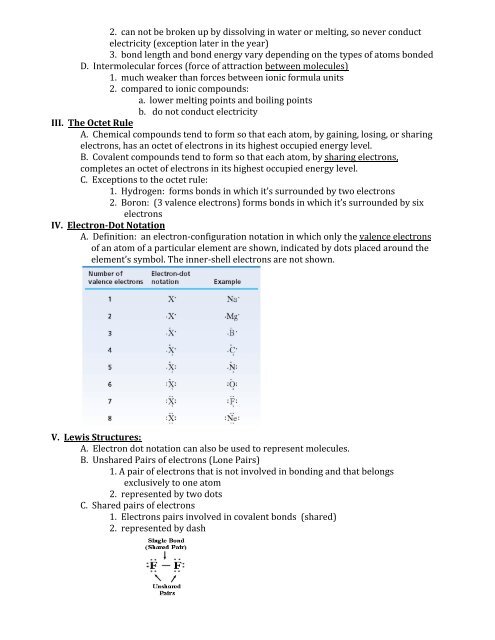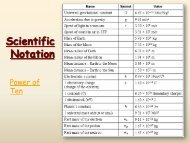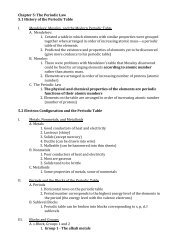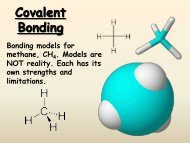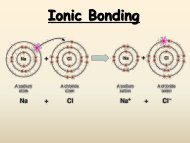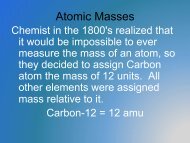Unit 4: Chemical Bonding and Molecular Structure Chapter 6 Notes ...
Unit 4: Chemical Bonding and Molecular Structure Chapter 6 Notes ...
Unit 4: Chemical Bonding and Molecular Structure Chapter 6 Notes ...
You also want an ePaper? Increase the reach of your titles
YUMPU automatically turns print PDFs into web optimized ePapers that Google loves.
2. can not be broken up by dissolving in water or melting, so never conduct <br />
electricity (exception later in the year) <br />
3. bond length <strong>and</strong> bond energy vary depending on the types of atoms bonded <br />
D. Intermolecular forces (force of attraction between molecules) <br />
1. much weaker than forces between ionic formula units <br />
2. compared to ionic compounds: <br />
a. lower melting points <strong>and</strong> boiling points <br />
b. do not conduct electricity <br />
III. The Octet Rule <br />
A. <strong>Chemical</strong> compounds tend to form so that each atom, by gaining, losing, or sharing <br />
electrons, has an octet of electrons in its highest occupied energy level. <br />
B. Covalent compounds tend to form so that each atom, by sharing electrons, <br />
completes an octet of electrons in its highest occupied energy level. <br />
C. Exceptions to the octet rule: <br />
1. Hydrogen: forms bonds in which it’s surrounded by two electrons <br />
2. Boron: (3 valence electrons) forms bonds in which it’s surrounded by six <br />
electrons <br />
IV. Electron-‐Dot Notation <br />
A. Definition: an electron-‐configuration notation in which only the valence electrons <br />
of an atom of a particular element are shown, indicated by dots placed around the <br />
element’s symbol. The inner-‐shell electrons are not shown. <br />
V. Lewis <strong>Structure</strong>s: <br />
A. Electron dot notation can also be used to represent molecules. <br />
B. Unshared Pairs of electrons (Lone Pairs) <br />
1. A pair of electrons that is not involved in bonding <strong>and</strong> that belongs <br />
exclusively to one atom <br />
2. represented by two dots <br />
C. Shared pairs of electrons <br />
1. Electrons pairs involved in covalent bonds (shared) <br />
2. represented by dash


